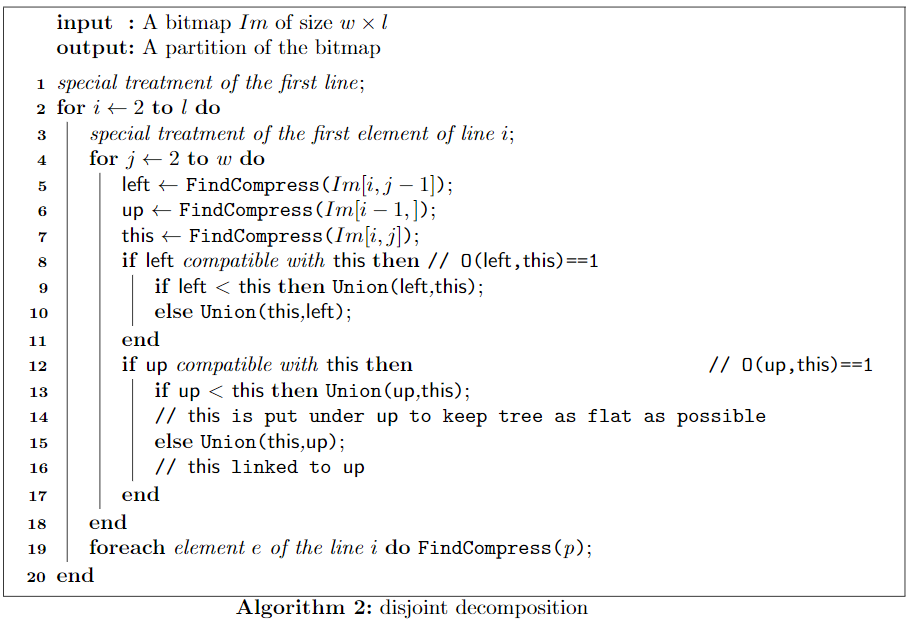科研基础3-伪代码规范
论文的编辑要插入两段伪代码,这里总结一下伪代码书写用到的 LaTeX 包和书写规范。
1. 伪代码规范
伪代码是一种接近自然语言的算法描述形式,其目的是在不涉及具体实现(各种编程语言)的情况下将算法的流程和含义清楚的表达出来,因此它没有一个统一的规范,有的仅仅是在长期的实践过程中形成的一些约定俗成的表达样式。下图是一个简单的例子1,但已经包含了大多数主要元素

首先需要一个标题来描述整个算法,一般还会有一个与之一起的编号。在上图中,算法的标题为「Acesscontrol algorithm flow」,编号为「Algorithm 1」。标题与编号一般位于算法顶部,但也有人放在底部,编号多按全文的算法总数进行索引,但也可以按章节分别进行索引。
其次,在正式的算法流之前需要声明输入和输出。通常使用关键字 Input 和 Output 来声明,但也有人使用关键字 Data 和 Result。
顺序、选择与循环结构是算法的主体。通常,不同的程序块使用缩进来保持结构清晰,但也有不少人使用垂直连接线进行进一步划分,如上图。另外,和编程语言类似,伪代码中的选择和循环使用 if-then-else、while-do 和 for-do 等关键字和结构来描述2,举例如下,其中,每个程序块结束的 end 关键字有人选择写,也有人选择不写。

赋值操作一般使用左箭头「<—」表示。A[i] 用来表示数组 A 的第 i 个元素,A[1…j] 则表示下标从 1 到 j 的子数组;函数调用使用函数名+传入参数的形式;返回值使用 return 关键字,这些都和常规编程语言相同。需要注意的是,未声明而使用的变量都可以视为算法内的局部变量,如果是全局变量则需要进行解释,可以在上下文中,也可以使用注释;注释的形式也和传统语言相同,使用 // 或 /*……*/。
算法整体通常使用三线框包围,但也有少部分人使用一个完整的框。
伪代码的语句一般不需要在末尾使用分号,但行首通常会添加行号。
2. LaTeX包
latex 书写伪代码主要有三种排版格式:algorithm+algorithmic、algorithm+algorithmicx 以及 algorithm2e3。我们使用 algorithm2e,它提供了垂直连接线,可以去掉 end 关键字,而且写起来更像编程语言,用着非常舒服。
引入 algorithm2e 包使用如下语句
| |
几个重要的 options 如下
- ruled:让标题显示在上面,默认会显示到最下面;
- vlined:默认启用垂直连接线;
- linesnumbered:让算法显示行号,不包括 input 和 output 部分;
- noend:程序块结束不打印 end。
常用命令如下4
| 命令 | 含义 |
|---|---|
| \caption{} | 插入标题 |
| \KwIn{输入信息} | 效果为:“In:输入信息” |
| \KwOut{输出信息} | 效果为:“Out:输出信息” |
| \For{条件}{循环语句} | for 条件 do 循环语句 end |
| \If{条件}{肯定语句} | if 条件 then 肯定语句 end |
| \While{条件}{循环语句} | while 条件 then 循环语句 end |
| \tcc{注释} | /*注释*/ |
| \tcp{注释} | // 注释 |
| \eIf{条件}{肯定语句}{否定语句} | if 条件 then 肯定语句 else 否定语句 end |
一个官方的例子如下
| |
渲染后的样式如下

注:当前算法选然后条件语句会带有下划线,主要是因为同时使用了 \ulem 包,产生了冲突,去掉该包即可
当算法过长,超过一页时,由于algorithm2e 没有提供相应的拆分机制,需要自己进行处理,文档描述如下
Caution: algorithms cannot be cut
自行拆分的方法是,在需要拆开的部分提前加入算法结束符,然后新建算法,示例如下,例子中省略了非必要的代码,但已足够说明如何使用,即只需要新开一个算法块,然后设定行号即可。
| |
P. Wang, Y. Yue, W. Sun and J. Liu, “An Attribute-Based Distributed Access Control for Blockchain-enabled IoT,” 2019 International Conference on Wireless and Mobile Computing, Networking and Communications (WiMob), Barcelona, Spain, 2019, pp. 1-6, doi: 10.1109/WiMOB.2019.8923232. ↩︎
Joe_WQ,latex 中的 algorithm 环境,简书,https://www.jianshu.com/p/fe9ba3c2424d ↩︎
熏风初入弦,用 LaTeX 优雅地书写伪代码—Algorithm2e 简明指南,知乎,https://zhuanlan.zhihu.com/p/166418214 ↩︎
 支付宝
支付宝 微信
微信